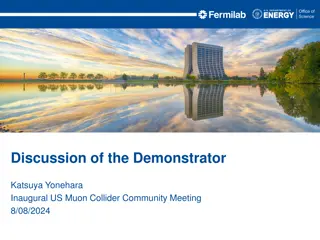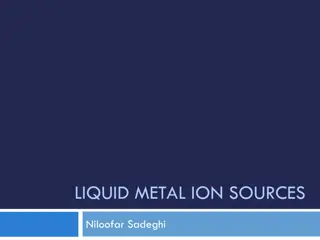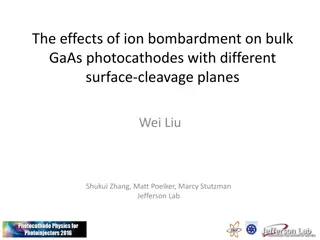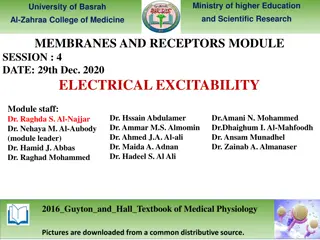Advancing Cyclotron Technology with Internal RF H-Ion Source
Explore the innovative Internal RF H-Ion Source for Cyclotrons funded by Horizon 2020. Revolutionize cyclotron technology with efficient ion production. Enhance beam quality and stability for advanced applications in research and industry.
0 views • 8 slides
Lithium-ion Battery Market
The global lithium-ion battery market size was valued at $46.2 billion in 2022, and lithium-ion battery industry is projected to reach $189.4 billion by 2032, growing at a CAGR of 15.2% from 2023 to 2032.
5 views • 6 slides
Update on MARCO Solenoid Magnet Design for Electron-Ion Collider User Group Meeting 2023
Valerio Calvelli from CEA Paris-Saclay presented the status of the MARCO Solenoid magnet for the Electron-Ion Collider User Group Meeting 2023. The presentation covered an overview of the detector solenoid, magnet specifications, design status, cold mass details, and interaction length limits, provi
0 views • 21 slides
Lithium-Ion Battery Anode Market Analysis Competitive Landscape & Growth Factors
Europe stands out as the world's number two consumer of lithium-ion battery anodes by value. This robust market is fueled by the growing demand for electric vehicles (EVs) within the region. Government incentives and funding play a crucial role in promoting EV adoption, which in turn, translates to
1 views • 4 slides
Introduction-to-Lithium-Batteries
We have access to higher lithium batteries for solar applications. We manufacture lithium-ion solar batteries, used in inverter batteries and electric automobiles\nWe have access to higher lithium batteries for solar applications. We manufacture lithium-ion solar batteries, used in inverter batterie
0 views • 8 slides
Lithium-Ion Battery Anode Market Size, Share, Industry Analysis and Segments
The global Lithium-Ion Battery Anode Market is projected to grow from USD 12.0 billion in 2023 to USD 46.5 billion by 2028, at a CAGR of 31.2% during the forecast period. The lithium-ion battery anode market is experiencing significant growth driven by the increase in demand for EVs, consumer elect
1 views • 5 slides
Advancements in Li-ion Battery Technology by Tekhno-Litiy
Tekhno-Litiy, a prominent manufacturer of Li-ion batteries, introduces higher capacity batteries with exceptional advantages such as high energy density, no memory effect, low self-discharging, and fast charging. They excel in the production of second-generation Li-ion batteries based on nano-struct
0 views • 5 slides
RF Considerations for High-Energy Muon Collider
This work package focuses on assessing feasibility issues and technological challenges of RF systems for a high-energy muon collider. Tasks include defining RF systems for acceleration and cooling complexes, addressing high gradients, beam loading, breakdown mitigation, and optimizing cavity distrib
0 views • 11 slides
Understanding Ion-Pair Chromatography (IPC): Theory and Applications
Ion-Pair Chromatography (IPC) involves adding ionic surfactants to a reversed-phase Chromatography system to affect retention and selectivity of ionic compounds. Developed by Dr. Gordon Schill, IPC is crucial for resolving hydrophilic samples and controlling selectivity in separations. The theory in
7 views • 18 slides
Exploring Heavy-Ion Collisions at CERN LHC: ALICE Experiment Overview
Unveiling insights into heavy-ion collisions at CERN's Large Hadron Collider (LHC) through the ALICE experiment. Delving into the status, performance, and initial results, ALICE aims to characterize the medium formed during collisions. With a collaboration of around 1000 members from 31 countries an
0 views • 29 slides
Experimental Reconstruction of Primary Hot Fragment in Heavy Ion Collisions
Investigation into primary hot fragment reconstruction at Fermi energy heavy ion collisions, utilizing experimental data and simulations to reconstruct excitation energy, mass, and charge of primary fragments. Techniques like kinematical focusing and isotope identification were employed, with a focu
0 views • 36 slides
Tasks of Alignment and Installation in CEPC Project
Tasks involved in the alignment and installation optimization of components in the Circular Electron Positron Collider (CEPC) project include control network construction, component installation, smooth alignment, and addressing any arising problems. The process is crucial for the successful operati
2 views • 19 slides
Cryogenic Gas Stopping Cell for High Precision Nuclear Physics Experiments
In the field of nuclear physics, high-quality ion beam parameters are essential for both primary and secondary beams. This report focuses on the cryogenic gas stopping cell, also known as a gas catcher, designed to transform rare ion beams from nuclear reactions into low-energy beams with small emit
1 views • 12 slides
Advancements in Chinese High-Energy Physics Research
Initiatives like the CEPC-SppC Study Group and Circular Electron Positron Collider (CEPC) showcase China's commitment to pioneering future collider projects. With a focus on the energy frontier, developments such as the upgrade to a 50-70 TeV pp collider indicate significant progress in the field. T
0 views • 32 slides
Understanding Ion Pumps and High Vacuum Systems
Explore the world of ion pumps and high vacuum systems, including the importance of creating a good vacuum, the different types of pumps available, the significance of ultra-high vacuum environments, and the features of ion pumps. Discover the technologies and processes involved, from chemisorption
0 views • 12 slides
Challenges and Upgrades in Electron-Ion Collider Interaction Regions
The article discusses vacuum issues, design challenges, and experiences in the interaction regions of Electron-Ion Colliders. It explores the unique characteristics of the HERA collider, including beam currents, bunch spacing, and straight sections. Additionally, it covers the upgrades and improveme
0 views • 25 slides
Future of Accelerator Technologies: Enhancing Colliders and R&D Programs
The Accelerator Frontier Panel discusses the crucial components to enable future accelerators, emphasizing the need for a National Future Collider R&D Program, General Accelerator R&D, and adequate accelerator and test facilities. The message stresses the importance of an integrated future collider
0 views • 17 slides
Advancements in Ion Beam Radiotherapy for Cancer Treatment
Ion beam radiotherapy, utilizing protons and carbon ions, offers precise dose localization with minimal damage to normal tissues, leading to effective treatment of solid cancers. This document discusses the benefits, challenges, and safety considerations of ion beam therapy, highlighting its signifi
0 views • 24 slides
Understanding Shuttling and Filtering of Multiple Ion Species in Segmented Linear Trap
This content delves into the intricate processes of shuttling and filtering multiple ion species within a segmented linear trap. It explores techniques such as RF filtering, DC potentials, mass filtering, and trap depths in the context of ion manipulation. Discussions also touch on ion crystal phase
0 views • 13 slides
Understanding Ion Channels in Cell Communication
Ion channels play a crucial role in cell communication by allowing ions to pass through cell membranes, controlling various cellular functions. Their high transport rate and electrochemical gradient differentiate them from other ion transporter proteins. Ion channels have diverse biological roles, i
0 views • 26 slides
Comparison of Photon, Proton, and Carbon Ion Therapy for Liver Cancer
This document elaborates on the comparison of photon, proton, and carbon ion therapy for liver cancer. It includes abstract, phantom CT scan analysis, organ delineation, photon vs. proton therapy comparisons, and proton vs. carbon ion therapy comparisons with corresponding images. Detailed discussio
0 views • 11 slides
Ion Beam Intensity Enhancement Through Electron Heating in Collider Experiments
The study discusses electron heating of ions in collider experiments at the Collider V. ParkhomchukBINP facility in Novosibirsk. It explores the effects of electron cooling on ion beams, ion beam oscillations, losses, and ion beam intensity enhancement. Various factors such as ion charge, classical
0 views • 9 slides
Analysis of Tune Variation and Decay in Large Hadron Collider
This analysis focuses on the tune variation and decay of the bare machine tune in the Large Hadron Collider. It covers the evolution of the bare tune, analysis of the tune decay after injection, fitting of decay constants, and data extraction from 2015. The study includes insights into beam commissi
0 views • 16 slides
Dynamic Aperture Study for Ion Ring Lattice Optimization
This study focuses on optimizing the dynamic aperture of the ion ring lattice, covering topics such as correct chromaticity, aperture scanning, effects of alignment and field errors, and correction procedures. The comparison of various lattice schemes provides insights into aperture characteristics,
0 views • 25 slides
Challenges and Considerations in Electron-Ion Collider Detector Development
Exploring the development of detector systems for Electron-Ion Colliders (EIC) involves addressing various issues such as detector acceptance for low Q2 and high Q2, unique beam characteristics, and the need for specialized components like bend magnets and polarimeters. Key considerations include po
0 views • 16 slides
SuperKEKB: Advancements in Electron-Positron Collider Technology
SuperKEKB is a cutting-edge circular collider facility that aims to push the boundaries of high-energy physics research. From addressing cloud challenges to conducting instability simulations, the facility has made significant strides in understanding beam dynamics and electron cloud effects. The co
0 views • 32 slides
Study on Energetic Particle Transport and Loss in Magnetic Confinement Systems
Investigation into energetic particle transport and loss induced by helically-trapped energetic-ion-driven resistive interchange modes in the Large Helical Device (LHD) for sustaining high-temperature and high-density plasmas. Utilizing neutron diagnostics and comprehensive neutron monitors, this st
0 views • 21 slides
Developments in Muon Collider Technology at the Inaugural US Muon Collider Community Meeting
Discussion at the US Muon Collider Community Meeting highlighted advancements in muon accelerator technology, with a focus on the Demonstrator by Katsuya Yonehara. Key topics included the layout of the muon accelerator complex, achievements in ionization cooling, and the MERcury Intense Target. The
0 views • 14 slides
Quarkonium in Medium and Transport in Heavy-Ion Collisions
Discussing the properties and behavior of quarkonium in medium and its transport in heavy-ion collisions. Topics include heavy-quark potential, confinement, quarkonia at finite temperature, quarkonium transport, and quarkonia in heavy-ion collisions. Insightful details about in-medium potential and
0 views • 30 slides
Project Task for Heavy Ion Physics Class at Mt. Csand Etvs University 2023/24 Spring Semester
This project involves analyzing real data from ultrarelativistic heavy ion collisions to measure physical observables such as elliptic flow (v2) or HBT radii (R) versus pT and centrality. It includes working with ROOT format data, setting up C++ and ROOT environments, installing necessary tools, and
0 views • 17 slides
Understanding Liquid Metal Ion Sources in Nanotechnology
Liquid Metal Ion Sources (LMIS) are crucial tools in nanotechnology, with needle and capillary types for ion emission. LMIS operate on the formation of liquid metal cones to emit ions, driven by electric fields and surface tension. Taylor cones and strong electric fields play key roles, while stabil
0 views • 10 slides
Insights on Magnetic Field Strength for Electron Ion Collider
Discussion on the requirements and advantages of different magnetic field strengths in detector solenoids at the Electron Ion Collider, emphasizing the impact on particle tracking, momentum resolution, and detector space needs. The analysis compares 1.5T and 3T fields, highlighting the implications
0 views • 9 slides
Advances in Radiation Monitoring Technology for Space Missions
Cutting-edge radiation monitoring technology developed by Jonathan Rae and the team at the Laboratory for Particle Physics, Paul Scherrer Institut, aims to provide in-situ measurements of protons, electrons, and ions for space missions. The LGR Radiation Monitor (RM) features improved detection tech
0 views • 8 slides
Ion Bombardment Effects on GaAs Photocathodes
Examining the impact of ion bombardment on bulk GaAs photocathodes with different surface-cleavage planes. Ion back-bombardment in photo-gun setups is a significant factor limiting the operating lifetime of photocathodes. Investigation includes H-ions implantation into GaAs, experimental apparatus d
0 views • 14 slides
Understanding Ion Calculations for Iron Element
Learn how to calculate the particles for an ion of iron (Fe) using the periodic table, including the number of protons, electrons, neutrons, and the mass number. Understand the notation of isotopes and how to determine the charge of an ion. Get the final answers for the Iron isotope with atomic numb
0 views • 10 slides
Advancements in Biological Treatment Planning for Ion Beams
Exploring the integration of biological effect information in treatment planning for ion beams, this collection of research discusses the importance of proper data accounting for enhanced patient-specific planning and beam selection. Topics include radiobiological needs, target and projectile fragme
0 views • 18 slides
Quarkonia Suppression in High Energy Heavy Ion Collisions by Roland Katz
Investigating the phenomenon of Quarkonia suppression in high energy heavy ion collisions, Roland Katz explores the properties of Quark Gluon Plasma and the behavior of quarks and gluons under extreme conditions. The study delves into the dynamics using the Schrödinger-Langevin equation, highlighti
0 views • 23 slides
Unraveling Collider Physics: Investigations, Interpretations, and Accelerations
Dive into the world of collider physics with a focus on LHC results, future collider projects, and experiments from the Baikal Summer School 2021. Explore topics like invariant mass calculations, Higgs boson decays, particle acceleration in the LHC tunnel, and particle velocity considerations. Engag
0 views • 10 slides
Understanding Membrane Excitability in Action Potentials
Explore the mechanisms of action potentials in nerve fibers, including the all-or-nothing principle, ion channels involved, ion movement, and effects of drugs on action potentials. Learn about accommodation, refractory periods, and consequences of blocking ion pumps on nerve conduction.
0 views • 8 slides
Understanding Lithium Ion Conduction in Li2(OH)Cl Through DFT Simulations
DFT simulations were conducted on the lithium ion conductor Li2(OH)Cl to investigate its low and high-temperature phases. The motivation behind the study was to uncover the structural features impacting the phase transition and diffusion properties of the material. The background highlighted two pha
0 views • 16 slides







































